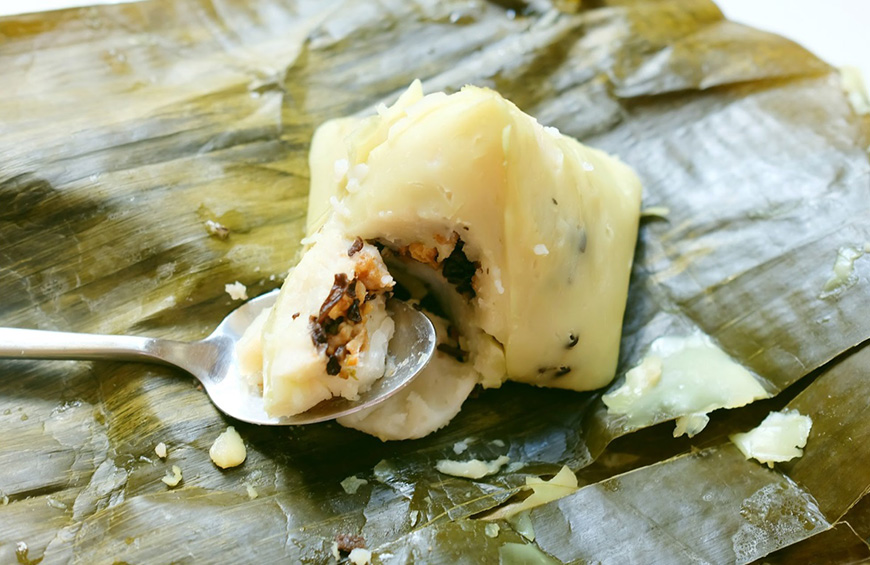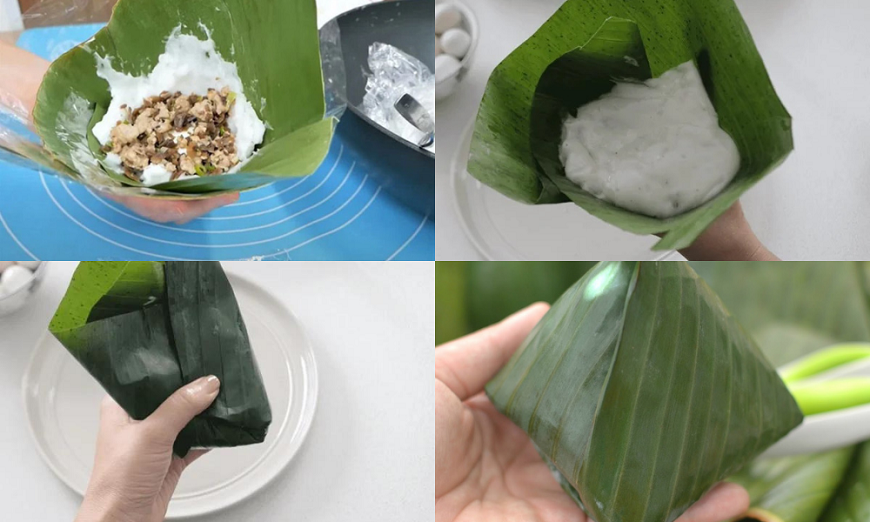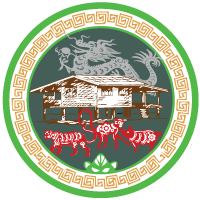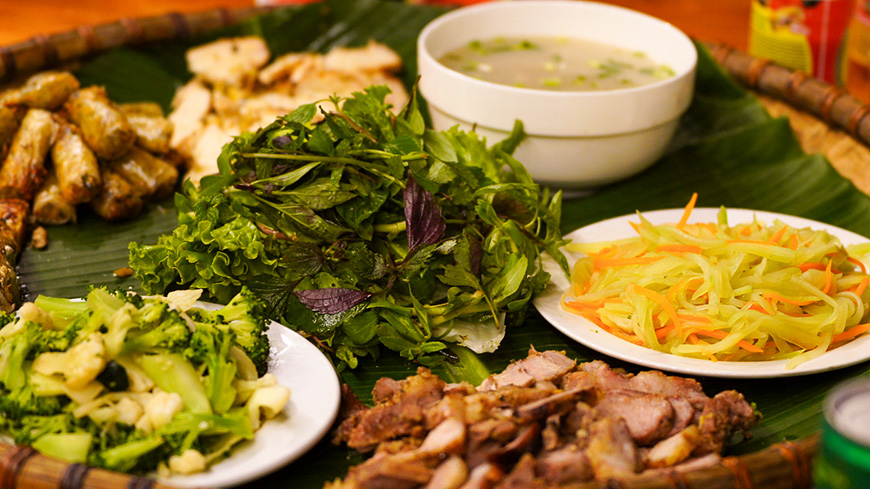Venturing into the Bac Kan mountains and along the shores of magnificent Lake Ba Be, travelers are transported into a world of culinary delights. Tasting the specialties of the Tay, Dao and Nung communities, as well as the fresh wonders of the lake, they discover the true essence of this region and the richness of its culinary traditions. It’s a true paradise for food lovers in search of unique and authentic taste experiences.
So, my gourmet friends, get your taste buds ready and set off to discover these incredible culinary delights!

A culinary journey to the heart of Ba Be’s ethnic groups
Let me reveal some of its most delicious gastronomic secrets.
Let’s start with the unmissable stars: the famous bánh cuốn Cao Bằng! These thin steamed rice pancakes, filled with a succulent stuffing of pork, black mushrooms and green onions… A real treat for the taste buds! Dipped in this sweet and sour nuoc mam sauce, they’re a pure delight.
And what about trying xôi ngũ sắc? This glutinous rice cooked with turmeric and pandan leaves will offer you an explosion of colors and flavors! It’s a festive and symbolic dish, often served on special occasions. A feast for the eyes and the taste buds!
But don’t stop there! Also try thịt chua, a fermented pork meat spiced up with aromatic herbs and spices. Its unique taste and melt-in-your-mouth texture make it an absolutely delicious side dish or appetizer.
And snack lovers will appreciate the lạp xưởng, dried and smoked pork sausages, sprinkled with salt, pepper and chilli. A delicious snack for your mountain hikes!

Discovering Tays flavours
But that’s just the beginning of your gustatory journey!
Among the Tay, you’ll discover such marvels as bánh cuốn mò, a sticky rice cake with a melting texture and delicate taste. Or khâu nhục, a stew of purple taro and pork belly, simmered in a mouth-watering sauce. Tay cuisine is also renowned for its Pẻng phạ, glutinous rice cakes previously ground to a powder, then mixed with a cup of wine and strong tea, instead of pure water. Dumplings are then baked and rolled in toasted glutinous rice powder. The cakes are then stuffed with minced pork, mushrooms and other ingredients, and grilled. Did you know? In the Tày language, “peng” means cake and “pha” means sky. Thus, peng pha is also known as sky cake (bánh trời). Because of this meaning, the Tày generally make it for important occasions, such as New Year’s Day or the Lông Tông festival (the festival of going down to the fields).
I almost forgot to tell you about lợn tộc đen, the meat of free-range black pigs raised in the mountains. Slow-cooked with herbs and spices, its tender flavor and strong taste are a perfect match for rice dishes.
Read more :
Ethnic Cuisine in Bac Kan
Diving into the culinary world of the Daos and Nung
But that’s not all!
The Dao and Nung also have some delicious surprises in store. Like bánh áp chao, fried fritters made from glutinous rice flour and mung beans. Or xôi ngũ sắc, multicolored glutinous rice cooked with edible flowers and leaves. An explosion of colors and flavors, to be enjoyed at parties and celebrations!
And what about the fresh fish caught in magnificent Lake Ba Be? Grilled, simmered or in fondue, they offer an unforgettable culinary experience. Take, for example, cá lăng nướng: this wood-grilled catfish is a classic of local cuisine. Its tender, flavorful flesh is enjoyed with a spicy sauce and fresh herbs. What’s not to love about canh chua cá lóc? This sweet-and-sour snakefish soup is a refreshingly fragrant dish, ideal for hot days. The light acidity of the broth and the freshness of the fish make it a must-try. And when it comes to fondue, try the unmissable lẩu cá tầm, a unique culinary experience based on sturgeon fish. The fish is cooked in a fragrant broth, accompanied by vegetables and rice vermicelli… a truly convivial feast.
So get ready for a real taste odyssey in the heart of Bac Kan! Let yourself be tempted by these authentic specialties, discover local products such as wild honey or cashew nuts, and soak up the culinary richness of this region. You’ll leave with a heart (and belly!) full of wonderful memories. Bon appétit, my gourmet friends!

If you’re hungry after hearing all these flavors, let me give you the recipe for Bánh Giò, a dish typical of North Vietnam and especially Hanoi. But, in Ba Be, they have an interesting version where they use “dó” leaves to wrap the dough and stuffing. But that’s not all. The leaves are dried and then reduced to ash before being sieved into a fine powder, which is then mixed with the rice paste to give Ba Be’s Bánh Giò a grayish color and slightly smoky flavor. The filling can also include additional ingredients such as mint leaves, basil or ginger.
But don’t worry, we’ll keep it simple. By the way, we don’t really know where Banh Gio comes from, but it probably dates back to the Nguyen dynasty (1802-1945) and is said to be an adaptation of a similar Chinese dish, Jiaozi.
Learn more about the Authentic flavors in Ba Be National Park
So much for today’s anecdote! Now for the recipe!

Recipe for Bánh Giò
(easy to prepare)
Ingredients
For the dough
- 2 cups rice flour
- 1 cup tapioca
- 6 cups chicken or pork stock (at room temperature)
For the stuffing
- 500 g ground pork
- 50 g dried black mushrooms
- 1 onion, chopped
- 1 tablespoon shallots, chopped
- 1 tablespoon vegetable oil
- Salt, sugar, pepper to taste
- Banana leaves
- Fish sauce
- Fresh chili pepper
Instructions
Prepare the dough: In a large bowl, mix the rice flour and tapioca. Gradually add the chicken or pork stock, stirring constantly until a smooth paste is obtained. Leave to rest for 30 minutes.
Prepare the filling: Soak the black mushrooms in hot water for 15 minutes. Drain and finely chop. Heat vegetable oil in a frying pan over medium heat. Add onion and shallots and sauté until tender. Add ground pork and cook until browned. Add black mushrooms, salt, sugar and pepper. Stir well and cook for a further 2 minutes. Remove from heat and allow to cool.
Assemble the Bánh Giò: Cut the banana leaves into 15 cm x 15 cm squares. Take a tablespoon of rice paste and place it in the center of a square of banana leaf. Add a tablespoon of filling to the center of the dough. Close the banana leaf, forming a cone or pyramid. See below for other assembly options.
Cook the Bánh Giò: Arrange the Bánh Giò in a steamer basket. Steam for 20-25 minutes, until the dough is translucent and the filling is cooked through.
Serving the Bánh Giò: Serve the Bánh Giò hot with fish sauce and fresh chilli pepper.
Enjoy your meal!

Tips
If you don’t have banana leaves, you can make banh gio in a bowl. Brush the bowl with oil, add the dough, the filling, another layer of dough and spread evenly. Cover with cling film to prevent condensation during steaming. Alternatively, use silicone muffin moulds.
If you have them, use glutinous rice flour instead of ordinary rice flour.
You can add other vegetables to the filling, such as carrots or peas.
Banh Gio can be stored in the refrigerator for 2-3 days. Reheat in steam before serving.

